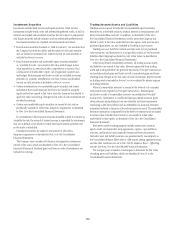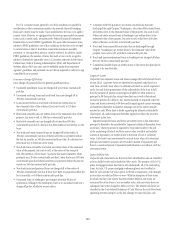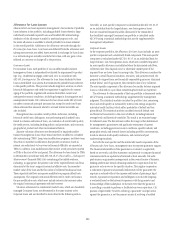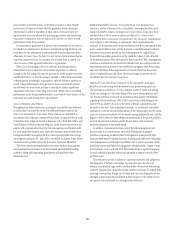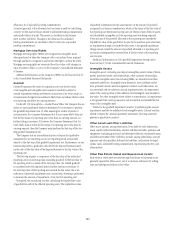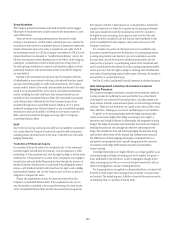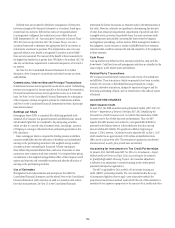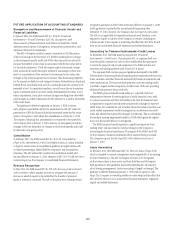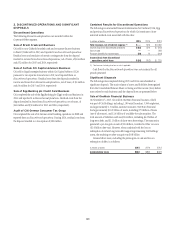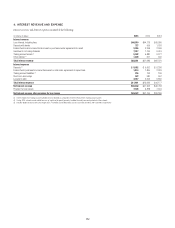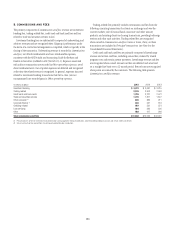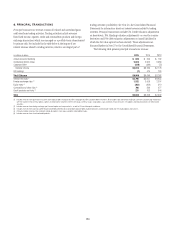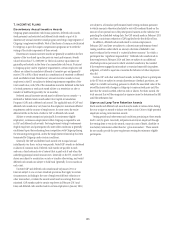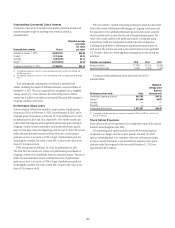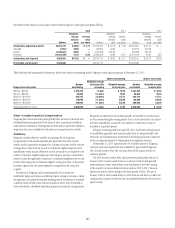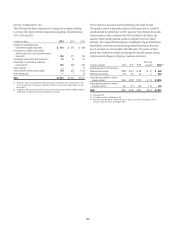Citibank 2015 Annual Report Download - page 166
Download and view the complete annual report
Please find page 166 of the 2015 Citibank annual report below. You can navigate through the pages in the report by either clicking on the pages listed below, or by using the keyword search tool below to find specific information within the annual report.148
FUTURE APPLICATION OF ACCOUNTING STANDARDS
Recognition and Measurement of Financial Assets and
Financial Liabilities
In January 2016, the FASB issued ASU No. 2016-01, Financial
Instruments—Overall (Subtopic 825-10): Recognition and
Measurement of Financial Assets and Financial Liabilities, which
addresses certain aspects of recognition, measurement, presentation, and
disclosure of financial instruments.
This ASU will require entities to present separately in OCI the portion
of the total change in the fair value of a liability resulting from a change
in the instrument-specific credit risk (DVA) when the entity has elected to
measure the liability at fair value in accordance with the fair value option
for financial instruments. It will also require equity investments (except
those accounted for under the equity method of accounting or those that
result in consolidation of the investee) to be measured at fair value with
changes in fair value recognized in net income, thus eliminating eligibility
for the current available-for-sale category. However, Federal Reserve Bank and
Federal Home Loan Bank stock as well as exchange seats will continue to be
presented at cost. As a practical expedient, an entity may choose to measure
equity investments that do not have readily determinable fair values at cost
minus impairment, if any, plus or minus changes resulting from observable
price changes in orderly transactions for the identical or a similar investment
of the same issuer.
The guidance is effective beginning on January 1, 2018; however,
early adoption is permitted only for the amendment in the ASU related to
presentation of DVA for financial liabilities measured under the fair value
option. Citi expects to early adopt this amendment as of January 1, 2016.
The impact of adopting this amendment is not expected to be material to
Citi’s balance sheet at January 1, 2016; however, in subsequent periods the
changes in DVA are dependent on changes in Citi’s credit spreads and could
be material in any given period.
Consolidation
In February 2015, the FASB issued ASU No. 2015-02, Consolidation
(Topic 810): Amendments to the Consolidation Analysis, which intended
to improve certain areas of consolidation guidance for legal entities such
as limited partnerships, limited liability companies, and securitization
structures. The ASU reduced the number of consolidation models and
became effective on January 1, 2016. Adoption of ASU 2015-02 did not have a
material impact on the Company’s Consolidated Financial Statements.
Revenue Recognition
In May 2014, the FASB issued ASU No. 2014-09, Revenue from Contracts
with Customers, which requires an entity to recognize the amount of
revenue to which it expects to be entitled for the transfer of promised
goods or services to customers. The ASU will replace most existing revenue
recognition guidance in GAAP when it becomes effective on January 1, 2018.
Early application is permitted for annual periods beginning after
December 15, 2016; however, the Company does not expect to early adopt.
The ASU is not applicable to financial instruments and, therefore, is not
expected to impact a majority of the Company’s revenue, including net
interest income. The Company is evaluating the effect that ASU 2014-09 will
have on its consolidated financial statements and related disclosures.
Accounting for Financial Instruments—Credit Losses
In December 2012, the FASB issued a proposed ASU, Financial
Instruments—Credit Losses. This proposed ASU, or exposure draft, was
issued for public comment in order to allow stakeholders the opportunity
to review the proposal and provide comments to the FASB and does not
constitute accounting guidance until a final ASU is issued.
The exposure draft contains proposed guidance developed by the FASB
with the goal of improving financial reporting about expected credit losses on
loans, securities and other financial assets held by financial institutions and
other organizations. The exposure draft proposes a new accounting model
intended to require earlier recognition of credit losses, while also providing
additional transparency about credit risk.
The FASB’s proposed model would utilize an “expected credit loss”
measurement objective for the recognition of credit losses for loans, held-
to-maturity securities and other receivables at the time the financial asset
is originated or acquired and adjusted each period for changes in expected
credit losses. For available-for-sale securities where fair value is less than cost,
credit-related impairment would be recognized in an allowance for credit
losses and adjusted each period for changes in credit risk. This would replace
the multiple existing impairment models in GAAP, which generally require
that a loss be incurred before it is recognized.
The FASB’s proposed model represents a significant departure from
existing GAAP, and may result in material changes to the Company’s
accounting for financial instruments. The impact of the FASB’s final ASU
on the Company’s financial statements will be assessed when it is issued.
The Company expects that the final ASU will be effective for Citi as of
January 1, 2019.
Lease Accounting
In February 2016, the FASB issued ASU No. 2016-02, Leases (Topic 842),
which is intended to increase transparency and comparability of accounting
for lease transactions. The ASU will require all leases to be recognized
on the balance sheet as lease assets and lease liabilities and will require
both quantitative and qualitative disclosures regarding key information
about leasing arrangements. Lessor accounting is largely unchanged. The
guidance is effective beginning January 1, 2019 with an option to early
adopt. The Company is evaluating whether to early adopt and the effect that
ASU 2016-02 will have on its consolidated financial statements, regulatory
capital and related disclosures.


